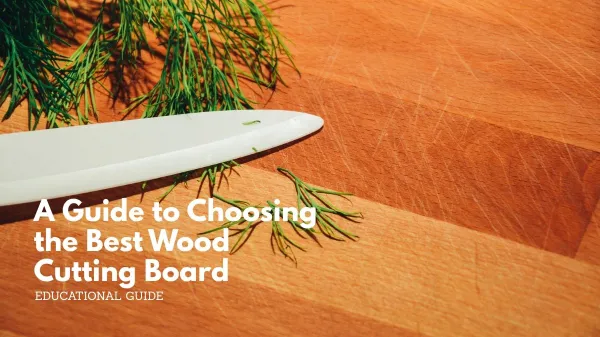A Guide to Choosing the Best Wood Cutting Board
I never realized how important it was to know about cutting boards until my mom decided to replace hers. As we started researching the best options, it turned into an eye-opening process for me as I explored the different types of wood, their properties, and how each one performs in the kitchen. That experience made me familiar with the various kinds of cutting boards and their material strengths, and it inspired me to share this knowledge with others who may also be searching for the perfect cutting board or considering an upgrade.
You might be asking yourself, “What’s the big deal about a wooden cutting board?” Well, if you care about your health and how your food affects your well-being, a wooden cutting board is an excellent choice. Wood is naturally resistant to toxins that can be released from plastic cutting boards. Not only that, it helps your knives stay sharper for longer. Have you also noticed how much a wooden cutting board adds to the beauty and aesthetic of a kitchen? These are just a few great reasons to consider getting one.
Since it can be difficult to find the right information to choose a suitable cutting board, this guide will provide a detailed analysis of different types of wood. It will give you the right information when you’re shopping for your own cutting board, just like I did for my mom.
Choosing the right cutting board is essential to your cooking lifestyle. There are various tasks we do with a cutting board, like cutting meat, chopping vegetables, and using it as a serving platter.
Table of Contents
Types of Wood Used
Walnut
The Walnut is a top choice for cutting boards. This is due to its durability, natural beauty, and practicality. It’s a good option if you are interested in adding aesthetics to every corner of your home including the kitchen.
Properties
Hardness and Durability
Walnut wood has a Janka hardness rating of 1,010, which makes it hard enough to resist damage and last for a long time. This makes it right for you if you want a rugged cutting board that will last decades. At the same time, it’s soft enough to allow shallow knife marks that self-heal, so you can be sure your knives won’t get dull.
Beauty
Walnut is well-known for its aesthetic qualities. Its color can range from pale shades to deep, rich dark brown with violet tones. If you’re looking for functionality and beauty in your kitchen, you’re making a great choice with walnut.
Antimicrobial Properties
This is a key benefit if you plan to use your walnut cutting board for meat. The wood has natural antimicrobial properties that help prevent bacteria from contaminating your food, making it an excellent choice for food safety.
Pros and Cons of Walnut
Pros
Durability
Walnut is known for its strength. It will last a long time, no matter how much you use it in your day-to-day kitchen activities.
Aesthetics
The unique grain pattern it can serve as a functional tool and an added feature for your home decor.
Stain- and Water-Repellent:
If you’re looking for a rugged cutting board, walnut is a good choice because it naturally repels stains and water.
Low Maintenance
it is also easy to maintain; washing with mild soap is enough to keep it clean.
Cons
Irregularity
While walnut’s grain pattern is good for home decor, it can be irregular. If you’re looking for a cutting board that blends seamlessly with a specific aesthetic, walnut boards may not always be the best choice.
Weight
They can be heavier than other wood boards, and over time, knife marks may become visible.
Teak Cutting Board
Teak is in the same class as walnut for its aesthetic appeal, extensive durability, and resistance to decay, making it a top consideration for cutting boards.
Properties
Durability
If you are looking for a cutting board that can stand the test of time, teak is an excellent option. You can get decades of service from it without decay, and it’s also rot- and termite-resistant.
Low Maintenance
Teak is water-resistant and isn’t affected by the weather. Teak cutting boards are known for being low maintenance because they contain natural oils that repel water, making them resistant to moisture absorption and bacterial growth.
Aesthetic Appeal
Teak has a different range of colors and grain patterns, which are mostly straight. This makes a cutting board made from teak an elegant addition to complement various kitchen styles.
Pros and Cons of Teak
Pros
Sustainability
When you source a correct teak wood, you can be sure of a sustainable cutting board that will last for years to come.
Food Safety
Teak boards offer you the benefit of food safety because of its natural oils. It limits the growth of bacteria, so you can rest assured that whatever you cut or slice on it will be safe.
Longevity for Knives
Teak cutting boards are hard with a soft surface, which is soft enough not to dull out your knives when using them on the board surface. This ensures that your knives stay sharp for a long time.
Cons
Maintenance
Despite being low maintenance, teak requires constant gentle washing and drying to avoid moisture damage. You have to carefully take care of it so it can serve you well for a long time.
Cost
One of the other sides of the Teak cutting board is that it’s more expensive in relation to other woods of its class. So you have to take more from your purse if you want to get it.
Knife Wear
Even though it’s a wood supportive of knives’ longevity, various sources have also indicated that due to its high silica content in relation to other woods, it can contribute to the wearing of your knives.
Maple Cutting Board
Maple is another good wood for cutting boards. It’s resistant to decay and adds beauty to the kitchen. You can use it for cutting all types of food, especially meat.
Properties
Antibacterial Properties
Maple ranks high among many other woods for its hygienic surface, which reduces the risk of contamination during food preparation.
Hardness
While there are various types of maple ranging in hardness, the durability is related to the amount of heavy-duty use the board can handle.
Surface Grain
The smooth surface of maple allows for easy cutting. It’s gentle on knives, yet durable enough to keep them sharp for a longer period.
Pros and Cons of Maple
Pros
Durability
It has high durability and can resist dents, scratches, and wear.
Cost
It’s also more budget-friendly compared to teak and walnut.
Aesthetics
If you are interested in home aesthetics, it’s a great choice.
Maintenance
It doesn’t need high-maintenance care, regular oiling will help it maintain its hardness. So you are good to go without much bother.
Cons
Staining
Due to its light color, it’s very prone to staining, which requires more cleaning.
Weight
If made in larger sizes, it can be difficult to move around the house because of its weight.
High Maintenance
It also requires a high level of maintenance with regular oiling to prevent it from cracking, drying, and splitting.
Bamboo
A surprise on this list is bamboo. It’s technically a grass rather than a wood, and it is less porous than many other wood materials. One of its benefits is that it is easy to clean and also very sustainable.
Properties
Lightweight
Bamboo is lightweight since it’s a grass, making it easy to move around the kitchen, regardless of its size.
Maintenance
A bamboo cutting board needs regular cleaning and proper care to keep it durable for a long time. This also helps reduce how bacteria can get into its surface pores.
Water Resistance
Bamboo is one of the best cutting boards to use in wet situations because it’s resistant to water, giving it a long life even with regular contact with moisture.
Pros and Cons of Bamboo
Pros
Cost-Effective
Bamboo boards are low-cost compared to other hardwoods, they aren’t as expensive as other woods. if you are looking to reduce splashing money on a board, it’s one of your top choices.
Portability
They’re also lightweight, making them easier to carry around the house.
Durability
Bamboo is very durable. You have to properly oil and care for it to avoid warping.
Cons
Toxicity
Because of its nature, it is often glued together, which can open it up to toxic chemicals that are not good for food safety over time.
Bacterial Risk
Bamboo can be very porous, making it easy for bacteria to lurk around and cause food infection.
Knife Durability
It has the potential to dull knives faster than other woods.
Acacia
Acacia is another great wood for cutting boards, as it’s gentle on knives, although it can be a bit heavy. It offers an aesthetic appeal to the kitchen and is easy to clean with periodic oiling.
Properties
Rich Grain and Colour
Acacia has a rich grain that brings out the beauty of the wood, and its range of colours makes it a good fit for home decor, in addition to its functionality.
Hardness and Durability
With a Janka hardness rating between 1,500 and 2,200, acacia is hard and durable enough to be used as a cutting board for years without wearing out.
Antibacterial Properties
Acacia wood has inherent antibacterial qualities, contributing to a safer and more hygienic food preparation surface.
Pros and Cons of Acacia
Pros
Durability
Due to its high Janka rating, acacia is resistant to scratches and dents, even with regular use.
Aesthetics
Acacia has a unique grain feature, which can make it serve not only as a cutting board, but also as a beauty item for home decor in the kitchen.
Weight
When compared to other woods, it has a moderate weight, making it movable.
Cons
Heat/Water Damage
It can be easily damaged when exposed to prolonged heat or water, which can have a negative effect on the surface of the board.
Fading
It also tends to lose its original colour after a while with regular use.
Quality
It’s possible to find lower-quality materials that will not stand the test of time. As common as the cutting board is, quality can vary significantly and bad quality comes with notable downsides.
Conclusion
After going through all the details about the different kinds of cutting boards, their properties, pros and cons, you can see that picking out the best choice depends on your priority and what you truly value most in them. If you want a board that offers beyond the functionality, also beauty, walnut and teak may be your choice. Maple will be a top choice for you if you are looking for something rugged, which will stand the test of time. Bamboo comes in if you want a mobile board that makes you move about in the kitchen.
With this guide, you are better informed to make a choice that will definitely serve you well.
if you are looking to go beyond your kitchen to invest in your dinning set, this articles is about common mistakes to avoid when getting your dinning table.

